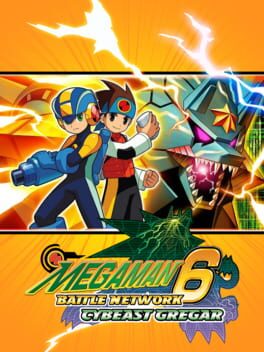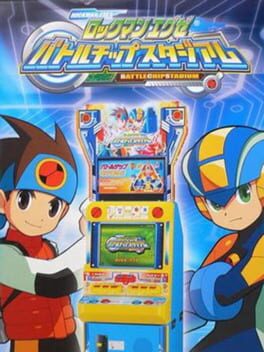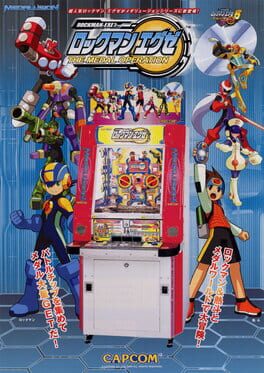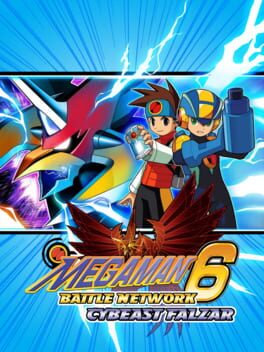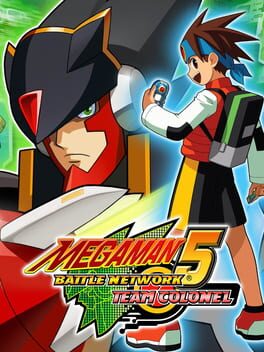

Mega Man Battle Network 6: Cybeast Gregar
released on Nov 23, 2005
In Mega Man Battle Network 6, Lan's father has received a job transfer and the family moves to Cyber City, a town known for conducting various technological experiments. Lan will meet new people and build new friendships in the real world while Mega Man befriends helpful Navis and encounters dangerous new enemies on the virtual plane. Together they will face threats far more powerful and perilous than they ever have before.
Also in series
Reviews View More
This review contains spoilers
After five (mostly) good entries it’s only natural to expect great things from a sixth and final installment to a tenured franchise such as Mega Man Battle Network. Yet, just because it’s a capstone entry does not guarantee success or quality. Mega Man Battle Network 6: Cybeast Gregar is a mixed bag of good and bad overall with the bad often undermining the good. Despite personal enjoyment and affection, I wish I could have gotten more out of my experience that rounds off this retrospective spanning almost a year. Improvements to existing systems and the return of proven systems make for a compelling reason to love this game. Poor writing and narrative design paired with questionable overall design choices limit how much you can engage with and appreciate those positive changes. After all, a game can feel good while still being bad. I insist that this Mega Man entry is good while leaving much to be desired.
The introduction brings about radical changes which feel necessary for the driving force behind the plot. For there to be titan programs capable of the sheer destruction and power demonstrated, it would almost certainly be required for them to exist somewhere we haven’t been to before. The Cybeasts, named Gregar and Falzar, still demand suspension of disbelief that you, the son of one of the greatest scientists in the world, would never have heard of these monsters before. In light of all that Lan has accomplished, it begs you to not consider this while proceeding with the plot. Regardless, the concept of MegaMan absorbing one of these great beasts is almost just as unbelievable were they not to give some sort of reason for it to work. At a surface level, this feels like a contrivance but given the history of MegaMan’s origins, it comes off as believable enough to move on from it.
The new characters that are introduced in this new setting have the potential to be compelling friends and allies, were they given more time to form attachments like that of Lan’s ACDC Town friends. Unfortunately, the narrative rushes you from the setup scenario to the crisis scenario before urgently pushing you to the next area so you can repeat the same formula until you reach the bittersweet end. The spaces occupied by these scenarios become bland the moment you resolve the crisis. These areas exist solely for the sake of the plot as the added NPCs do little to contribute to the intended “lived-in” feeling. We see this type of setup in previous Battle Network games too but usually, there’s a little bit more to justify the setting beyond the facilities that are rooted in these spaces. Places like Yoka in 3 have the zoo and the hotel with the hot springs and 5’s SciLab has a pathway to the marina. Nothing like that exists within Battle Network 6 and the game is worse for it. None of these places feel connected to each other either as half of these places are in unconventional spaces like the sky or out in nature.
The themes present in these areas go beyond their appearance too. This is most apparent in the Green Area where Cyber City’s justice system resides. The themes present in Green Area go further than what I imagine the developers intended. The idea of using program-based judgment works when you consider how all of net society relies on technology and its integrations into a daily living but when you take a step back and consider the social ramifications behind computer-based judgment it becomes immediately off-putting. Who put in the parameters that define justice? Is the computer capable of understanding nuance and contextualization? What happens when the computer reaches the wrong verdict? Furthermore, is it ethical for a prosecutor to create such a system and still do their job under the pretense that they designed that system? These are all questions that I don’t believe were intended to be explored by this area, especially with how quickly the plot resolves and the game moves on. All of these factors don’t even acknowledge the fact that justice has been weirdly married to environmentalism. None of this translates to the net aside from the background and a few cyber-trees that block your path.
The net design is perhaps, the greatest it’s been since Battle Network 3. While visually it’s about what you have grown to expect throughout the series, the layout is highly intuitive and is easy to follow and remember how to navigate. Obstacles are less present in favor of offering you shortcuts to navigate through areas quickly. The rush biscuits open up the opportunity to spend your gratuitous amount of money accrued from battle and then create paths that allow you to find otherwise inaccessible items or spaces. This is a completely missable feature but it’s incredibly useful for those repeat journeys through the net. Obstacles can also be cleared by using one of the various Link Navis that you obtain throughout the game. The Link Navi system is the continuation of Battle Network 5’s system that allowed Lan to operate other characters’ Navis. In this game, Lan is permitted to explore the net with some returning characters along with some new faces. Getting to run around as Navis such as HeatMan and ElecMan was a pleasant way to change up the gameplay and challenge you to synergize with these Navis. This also allowed you to clear the barriers that were present throughout the net. This could be tedious at times due to the static starting point of each Navi but it overall lends itself to a pleasant experience. Of course, the best part of exploring the net is busting viruses and gathering battle chips.
Gathering battle chips has never been better. The chip selection, accessibility, and synergy are next level. From the beginning, it’s easy to narrow your folder down to a couple of chip codes. Regular memory is available in abundance and the new tag system makes it even easier for you to put together Program Advances or set up to use chips more efficiently, all of which adds up to an excellent combat system. The problem is that the battle chips are too strong. Immediately upon arrival, you can gather chips that do sixty or more damage. Your folder starts with very fast-acting chips that do a lot of damage as well. This is most present with new chips. A lot of the Navi boss chips do a ton of damage and have low regular memory requirements. Like BlastMan, his basic chips do a lot of damage and only require 30MB to select as your regular chip. This allows for combat to be heavily trivialized and undermines any need for other systems that are present in combat. Namely, the Double Soul system that was rebranded to the Cross system and the new Beast Mode that is introduced when MegaMan absorbs Cybeast Gregar.
The Cross system is a feature that’s introduced with the Link Navis. It allows MegaMan to adopt the physical properties of the Link Navis and boosts the power of their respective elements. The crosses you obtain throughout the game are very powerful in their own respect. Specifically, HeatCross and SlashCross are the first two you can obtain and are incredibly strong. If there were tougher viruses to face the Cross system would have been critical to helping you compete but as mentioned before, battle chips are so strong that you only feel the need to use this system during boss battles. Any other time the animations and process of using the ability would take longer than the battle itself. This system synergizes well with Beast Mode though. Beast Mode boosts the strength of elementless chips and also gives you the ability to jump into the effective damage range of a chip before using it. This aids in hitting enemies while you’re also taking evasive action but it could also leave you vulnerable for an attack. The strongest implementation is the combining of the two systems. Combining a Cross with Beast Mode changes how the affected chips work. Depending on which Cross you use, combined with Beast Mode greatly magnifies the effects and strength of your battle chips. Effects like turning your chips into a seven-tile burning attack or adding a stunning effect to your electric chips. This is well presented and fun to use but it further trivializes content. All of these factors rush you through the game until you reach the end.
After facing off with the titular Cybeast, Gregar, you have finally reached the end of not only Mega Man Battle Network 6: Cybeast Gregar, but you’ve also reached the end of the Battle Network series as a whole. While the franchise has had many ups and downs, this particular title perhaps has the deepest valleys in terms of storytelling while having the highest peaks in terms of gameplay elements. The gameplay feels so good that if you’re not paying attention you could miss just how poorly the writing and execution of this game’s narrative is. Breaking an established character’s behavior in an attempt to misdirect and then justifying it with an incredibly vague backstory is more frustrating than anything that has been done, narratively speaking, in the entire series. This is compounded by the fact that they gave this backstory to two different characters. At least with one of those characters it works because that character wasn’t established as morally grounded as the other character was. Then to right the wrong the characters basically admit because an eleven-year-old said it was bad and they should feel bad, that they were bad and feel bad for their part in the main villain’s plot.
Afterward, we’re given a few scenes that depict Lan and all of his friends talking about what they want to do when they grow up and the game ties it off with a proverbial bow that reads “and so they did.” It’s about as fulfilling as the narrative that we just experienced and it reminds you of how haphazardly this story has been put together. Between the linear area introductions and the immediate crisis that resolves just as swiftly, you’re left with a sentiment akin to “That’s it?” when the sentiment should be one of amazement. The Battle Network series as a whole has been a worthwhile experience, yet with this conclusion I’m left dissatisfied and desiring a follow-up containing a stronger ending. For as much fun as Mega Man Battle Network 6: Cybeast Gregar was to play, as a final installment to an otherwise fantastic series I am left sorely disappointed.
The introduction brings about radical changes which feel necessary for the driving force behind the plot. For there to be titan programs capable of the sheer destruction and power demonstrated, it would almost certainly be required for them to exist somewhere we haven’t been to before. The Cybeasts, named Gregar and Falzar, still demand suspension of disbelief that you, the son of one of the greatest scientists in the world, would never have heard of these monsters before. In light of all that Lan has accomplished, it begs you to not consider this while proceeding with the plot. Regardless, the concept of MegaMan absorbing one of these great beasts is almost just as unbelievable were they not to give some sort of reason for it to work. At a surface level, this feels like a contrivance but given the history of MegaMan’s origins, it comes off as believable enough to move on from it.
The new characters that are introduced in this new setting have the potential to be compelling friends and allies, were they given more time to form attachments like that of Lan’s ACDC Town friends. Unfortunately, the narrative rushes you from the setup scenario to the crisis scenario before urgently pushing you to the next area so you can repeat the same formula until you reach the bittersweet end. The spaces occupied by these scenarios become bland the moment you resolve the crisis. These areas exist solely for the sake of the plot as the added NPCs do little to contribute to the intended “lived-in” feeling. We see this type of setup in previous Battle Network games too but usually, there’s a little bit more to justify the setting beyond the facilities that are rooted in these spaces. Places like Yoka in 3 have the zoo and the hotel with the hot springs and 5’s SciLab has a pathway to the marina. Nothing like that exists within Battle Network 6 and the game is worse for it. None of these places feel connected to each other either as half of these places are in unconventional spaces like the sky or out in nature.
The themes present in these areas go beyond their appearance too. This is most apparent in the Green Area where Cyber City’s justice system resides. The themes present in Green Area go further than what I imagine the developers intended. The idea of using program-based judgment works when you consider how all of net society relies on technology and its integrations into a daily living but when you take a step back and consider the social ramifications behind computer-based judgment it becomes immediately off-putting. Who put in the parameters that define justice? Is the computer capable of understanding nuance and contextualization? What happens when the computer reaches the wrong verdict? Furthermore, is it ethical for a prosecutor to create such a system and still do their job under the pretense that they designed that system? These are all questions that I don’t believe were intended to be explored by this area, especially with how quickly the plot resolves and the game moves on. All of these factors don’t even acknowledge the fact that justice has been weirdly married to environmentalism. None of this translates to the net aside from the background and a few cyber-trees that block your path.
The net design is perhaps, the greatest it’s been since Battle Network 3. While visually it’s about what you have grown to expect throughout the series, the layout is highly intuitive and is easy to follow and remember how to navigate. Obstacles are less present in favor of offering you shortcuts to navigate through areas quickly. The rush biscuits open up the opportunity to spend your gratuitous amount of money accrued from battle and then create paths that allow you to find otherwise inaccessible items or spaces. This is a completely missable feature but it’s incredibly useful for those repeat journeys through the net. Obstacles can also be cleared by using one of the various Link Navis that you obtain throughout the game. The Link Navi system is the continuation of Battle Network 5’s system that allowed Lan to operate other characters’ Navis. In this game, Lan is permitted to explore the net with some returning characters along with some new faces. Getting to run around as Navis such as HeatMan and ElecMan was a pleasant way to change up the gameplay and challenge you to synergize with these Navis. This also allowed you to clear the barriers that were present throughout the net. This could be tedious at times due to the static starting point of each Navi but it overall lends itself to a pleasant experience. Of course, the best part of exploring the net is busting viruses and gathering battle chips.
Gathering battle chips has never been better. The chip selection, accessibility, and synergy are next level. From the beginning, it’s easy to narrow your folder down to a couple of chip codes. Regular memory is available in abundance and the new tag system makes it even easier for you to put together Program Advances or set up to use chips more efficiently, all of which adds up to an excellent combat system. The problem is that the battle chips are too strong. Immediately upon arrival, you can gather chips that do sixty or more damage. Your folder starts with very fast-acting chips that do a lot of damage as well. This is most present with new chips. A lot of the Navi boss chips do a ton of damage and have low regular memory requirements. Like BlastMan, his basic chips do a lot of damage and only require 30MB to select as your regular chip. This allows for combat to be heavily trivialized and undermines any need for other systems that are present in combat. Namely, the Double Soul system that was rebranded to the Cross system and the new Beast Mode that is introduced when MegaMan absorbs Cybeast Gregar.
The Cross system is a feature that’s introduced with the Link Navis. It allows MegaMan to adopt the physical properties of the Link Navis and boosts the power of their respective elements. The crosses you obtain throughout the game are very powerful in their own respect. Specifically, HeatCross and SlashCross are the first two you can obtain and are incredibly strong. If there were tougher viruses to face the Cross system would have been critical to helping you compete but as mentioned before, battle chips are so strong that you only feel the need to use this system during boss battles. Any other time the animations and process of using the ability would take longer than the battle itself. This system synergizes well with Beast Mode though. Beast Mode boosts the strength of elementless chips and also gives you the ability to jump into the effective damage range of a chip before using it. This aids in hitting enemies while you’re also taking evasive action but it could also leave you vulnerable for an attack. The strongest implementation is the combining of the two systems. Combining a Cross with Beast Mode changes how the affected chips work. Depending on which Cross you use, combined with Beast Mode greatly magnifies the effects and strength of your battle chips. Effects like turning your chips into a seven-tile burning attack or adding a stunning effect to your electric chips. This is well presented and fun to use but it further trivializes content. All of these factors rush you through the game until you reach the end.
After facing off with the titular Cybeast, Gregar, you have finally reached the end of not only Mega Man Battle Network 6: Cybeast Gregar, but you’ve also reached the end of the Battle Network series as a whole. While the franchise has had many ups and downs, this particular title perhaps has the deepest valleys in terms of storytelling while having the highest peaks in terms of gameplay elements. The gameplay feels so good that if you’re not paying attention you could miss just how poorly the writing and execution of this game’s narrative is. Breaking an established character’s behavior in an attempt to misdirect and then justifying it with an incredibly vague backstory is more frustrating than anything that has been done, narratively speaking, in the entire series. This is compounded by the fact that they gave this backstory to two different characters. At least with one of those characters it works because that character wasn’t established as morally grounded as the other character was. Then to right the wrong the characters basically admit because an eleven-year-old said it was bad and they should feel bad, that they were bad and feel bad for their part in the main villain’s plot.
Afterward, we’re given a few scenes that depict Lan and all of his friends talking about what they want to do when they grow up and the game ties it off with a proverbial bow that reads “and so they did.” It’s about as fulfilling as the narrative that we just experienced and it reminds you of how haphazardly this story has been put together. Between the linear area introductions and the immediate crisis that resolves just as swiftly, you’re left with a sentiment akin to “That’s it?” when the sentiment should be one of amazement. The Battle Network series as a whole has been a worthwhile experience, yet with this conclusion I’m left dissatisfied and desiring a follow-up containing a stronger ending. For as much fun as Mega Man Battle Network 6: Cybeast Gregar was to play, as a final installment to an otherwise fantastic series I am left sorely disappointed.
Woah cool systems given to you early and quality of life! It only took them 6 games! Story and gameplay loop really do nothing new. Was going through the motions, that combined with this being perhaps the easiest game made the whole playthrough very blah. Or I'm just fatigued after so many games and so little change. This may be one of the best (or most popular) for PVP but it's nothing special single player wise.
This review contains spoilers
Tenta ser o que mmbn 3 foi, e atinge o mmbn 1, fraco em poucas palavras.
Diferente da desgraça do 4, sinto que aqui ele tentou ser bom, e ela agrada bastante com os gráficos e level design de dungeon. Eu gostava das liberation missions do battle network 5, mas eu prefiro muito mais o estilo clássico, os puzzles são bons, ao invés de serem arrastados, e ritmo de jogo flui mais aqui. O que me incomodou mesmo foi os chefes, eles só vão ser um real desafio na reta final, porque todos são uns bando de tartaruga que não possui variedade de ataques e são lentos, a maioria, sem brincadeira, matei fazendo no damage, nem os chefes do bn 4 são tão ruins assim.
Esse é o sexto jogo, e por algum diabos de motivo ainda não tem mapa nele, sei que no bn 5 tinha um mapa na versão de ds, mas era tão difícil criar um menuzinho no start? Caramba, parece que é má vontade. O level design não é confuso, porém um mapa ajudaria aos iniciantes à se localizarem.
O que ficou fraco aqui foi a trilha sonora. Não sei porque elas enfraqueceram tanto, nem as de combate dão tanta emoção assim, a maioria dos temas são esqueciveis, a não ser a dungeon final que tem a obrigação de ser boa.
Não entendo direito o motivo de trocaram os amigos de lan, ainda mais com eles tendo um vaso desenvolvimento, e ao invés de aprimorarem os personagens já estabelecidos e amados na série, eles decidiram colocar 2 bonecos novos, um é inútil na trama e só serve pra preencher o estereótipo de nerd, e o outro é o Mick, que possui sua graça. No início, Mick sente inveja de lan, por possuir um navi mais poderoso que o dele, então ele decide se juntar com um navi problemático para se provar superior, uma motivação simples e que consegue ser superior a do bn 2, que era "oh, eu odeio todos os humanos porque eles me menosprezaram", vão tudo se fuder, eu quero ver personagem humano com motivações identificáveis.
O que não entendo na história é eles ficarem repetindo toda hora que o megaman é o irmão do lan. Pô, cara, isso já aconteceu umas... sei lá, 4 vezes? E lan ainda continua tratando hub como seu cachorrinho, isso é meio psicopata, e já aconteceu tantas vezes que nas novas vezes, perdem o peso, e isso também ocorre com bass. Todo santo jogo esse desgraçado está de alguma forma, e já perdeu a graça da aparição dele, nem me importo mais com a revelação dele na trama, isso era previsível.
E outra coisa que odiei foi o desenvolvimento de personagens, a iris aparece como um boneco misterioso, e que é bom ver o desenvolvimento dela, para no final revelar que ela era uma navi controlando um boneco, o que explica bastante o como ela ajudou na trama, e sua morte é triste de certa forma. Por outro lado temos o colonel, que se tu não jogou a versão dele no battle network 5, tu nem vai ter afeto pelo personagem, e ainda mais pelo dono dele. Eles simplesmente só são utilizados na trama para fazer ela se movimentar, sem dar uma real motivação ou motivo pra eu me interessar por eles.
Acho triste a série terminar assim, um final fraco que soa como "quando o sétimo jogo vai lançar agora?", no que ele tem de bom, ele tem muitos pontos fracos que deixa ele inferior no ponto de história, a gameplay sempre foi boa em battle network, porém não devemos nos esquecer que eles são rpgs, e rpgs servem para ter foco narrativo, ou temas no qual querem abrangir, infelizmente battle network peca muito nisso, querendo focar no bobo e no infantil, ao invés de seguir simples como o primeiro jogo, ou ter uma boa trama como o 3.
Diferente da desgraça do 4, sinto que aqui ele tentou ser bom, e ela agrada bastante com os gráficos e level design de dungeon. Eu gostava das liberation missions do battle network 5, mas eu prefiro muito mais o estilo clássico, os puzzles são bons, ao invés de serem arrastados, e ritmo de jogo flui mais aqui. O que me incomodou mesmo foi os chefes, eles só vão ser um real desafio na reta final, porque todos são uns bando de tartaruga que não possui variedade de ataques e são lentos, a maioria, sem brincadeira, matei fazendo no damage, nem os chefes do bn 4 são tão ruins assim.
Esse é o sexto jogo, e por algum diabos de motivo ainda não tem mapa nele, sei que no bn 5 tinha um mapa na versão de ds, mas era tão difícil criar um menuzinho no start? Caramba, parece que é má vontade. O level design não é confuso, porém um mapa ajudaria aos iniciantes à se localizarem.
O que ficou fraco aqui foi a trilha sonora. Não sei porque elas enfraqueceram tanto, nem as de combate dão tanta emoção assim, a maioria dos temas são esqueciveis, a não ser a dungeon final que tem a obrigação de ser boa.
Não entendo direito o motivo de trocaram os amigos de lan, ainda mais com eles tendo um vaso desenvolvimento, e ao invés de aprimorarem os personagens já estabelecidos e amados na série, eles decidiram colocar 2 bonecos novos, um é inútil na trama e só serve pra preencher o estereótipo de nerd, e o outro é o Mick, que possui sua graça. No início, Mick sente inveja de lan, por possuir um navi mais poderoso que o dele, então ele decide se juntar com um navi problemático para se provar superior, uma motivação simples e que consegue ser superior a do bn 2, que era "oh, eu odeio todos os humanos porque eles me menosprezaram", vão tudo se fuder, eu quero ver personagem humano com motivações identificáveis.
O que não entendo na história é eles ficarem repetindo toda hora que o megaman é o irmão do lan. Pô, cara, isso já aconteceu umas... sei lá, 4 vezes? E lan ainda continua tratando hub como seu cachorrinho, isso é meio psicopata, e já aconteceu tantas vezes que nas novas vezes, perdem o peso, e isso também ocorre com bass. Todo santo jogo esse desgraçado está de alguma forma, e já perdeu a graça da aparição dele, nem me importo mais com a revelação dele na trama, isso era previsível.
E outra coisa que odiei foi o desenvolvimento de personagens, a iris aparece como um boneco misterioso, e que é bom ver o desenvolvimento dela, para no final revelar que ela era uma navi controlando um boneco, o que explica bastante o como ela ajudou na trama, e sua morte é triste de certa forma. Por outro lado temos o colonel, que se tu não jogou a versão dele no battle network 5, tu nem vai ter afeto pelo personagem, e ainda mais pelo dono dele. Eles simplesmente só são utilizados na trama para fazer ela se movimentar, sem dar uma real motivação ou motivo pra eu me interessar por eles.
Acho triste a série terminar assim, um final fraco que soa como "quando o sétimo jogo vai lançar agora?", no que ele tem de bom, ele tem muitos pontos fracos que deixa ele inferior no ponto de história, a gameplay sempre foi boa em battle network, porém não devemos nos esquecer que eles são rpgs, e rpgs servem para ter foco narrativo, ou temas no qual querem abrangir, infelizmente battle network peca muito nisso, querendo focar no bobo e no infantil, ao invés de seguir simples como o primeiro jogo, ou ter uma boa trama como o 3.
Gameplay-wise it's the strongest entry in the series. I really missed Liberation Missions, but everything else in the game is amazing. The story is cool, changing most of the side characters was a good move, as they got boring after 5 games. Classic MMBN filler is still here, but there's just so much content here that it's barely noticeable. CrossSoul is much better than DoubleSoul as a mechanic, and Beastcross enhances it even more. PvP is also at its best here.
